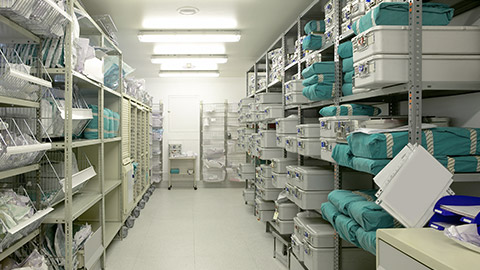In this section you will learn to:
- Identify, respond to and communicate potential or actual risk of, or breach in, infection control.
- Assess the risk and take appropriate immediate action in accordance with industry and organisational guidelines.
- Communicate any breach in infection control and risk management strategies in place to the supervisor, manager or responsible authority and seek advice on actions required following a breach in infection control..
- Implement control measures to minimise contamination of people, materials, and equipment.
- Document incidents and responses and report according to organisational policies and procedures.
- Ensure all records, materials and equipment are stored in a designated clean area.
Supplementary materials relevant to this section:
- Reading E: Managing Work Health and Safety During Covid-19
- Reading F: Communication for Patient Safety
In the previous section of this module, you were introduced to specific hygiene procedures and necessary care. You also learned about the necessary precautions when it comes to waste management and asepsis. However, the responsibility for the prevention and control of healthcare-associated infections does not rest with the Infection Prevention and Control Team. It is an organisational responsibility, an integral component of patient-centred care, and it is the responsibility of all staff to ensure that it is embedded into every aspect of patient care all of the time.
Reading E - Managing Work Health and Safety During Covid-19
Reading E is a set of guidelines that will assist workers and employers to meet their obligations under the Work Health and Safety Act 2011 (WHS Act) during the COVID-19 pandemic.

When you begin work in the Allied Health field, always review the organisation’s policies and procedures. These are your guiding documents that will shape your professional development in your job role. Each policy is an overarching document about a particular area relevant to your role. The procedure is the steppingstone to how you will achieve your position ethically and professionally. Note that policies can also include relevant legislative framework, which informs a particular area. The NSW Government provides key explanatory and examples of the role of policies and procedures in an organisation. In viewing the policies and procedures of your organisation, note that one of the values of those documents is to develop a shared understanding amongst those who work and have contact with organizational members. Obligations in terms of particular statutory and legislative requirements, for example, Work Health and Safety, will be highlighted in relevant policies and procedures. Indeed (2023) gives some examples of policies and procedures that will also be relevant in the Allied Health field. You will find that policies and procedures, to be most effective, are regularly updated and reflective of current professional standards and legislation.
Risk management

Risk management is a proactive approach, and its aim is to prevent or minimise harm. The implementation of a formal risk management process will identify potential problems and the potential for harm to patients. Once the risks are identified, actions are then planned to reduce the likelihood of the problem arising or to limit the harm caused.
‘The four key stages’
| Steps taken | Explanation |
|---|---|
| 1. Risk identification | This stage involves:
|
| 2. Risk control |
This stage estimates the likely consequence that the identified risks might have on the patient. You may use the following key questions to analyse the risks involved:
|
| 3. Risk control |
|
| 4. Risk monitoring |
|
Recording and documenting risks and incidents

At first, your supervisor or other HCWs will ask for a clear description of the incident with as much detail as possible. This will help them assess whether or not the incident is notifiable and the need for a follow-up investigation. The following information has been recommended by Safe Work Australia (2015):
| What happened? |
|
| When did it happen? |
Date and time |
| Where did it happen? |
|
| What happened? |
Detailed description of the notifiable incident |
| Who did it happen to? |
|
| How and where are they being treated (if applicable)? |
|
| Who is the person conducting the business or undertaking (there may be more than one)? |
|
| What has/is being done? | Action taken or intended to be taken to prevent recurrence (if any). |
| Who is to be notified? |
|
Reporting risks and incidents
A safety reporting process will help you identify health and safety issues, why they occurred and how to fix them.
Some things should be encouraged within the healthcare facility and its workers:
- Injuries, illnesses and fatalities
- Near misses
- Damaged or faulty equipment
- Housekeeping issues
- Health and safety hazards
- Suggestions for improvement
By encouraging the reporting of hazards, near misses, and maintenance problems, you can help stop incidents from occurring. You must report any health and safety issues that you may come across in order to prevent infection this can be done through the following individuals:
- Supervisor: this person would be a HCW’s first point of contact depending on the assessment of the risk.
- General practitioners: serves as a specialist advisor and takes a leading role in the effective functioning of the infection and prevention control (IPC) team. In allied health a GP might not always be present, however we need to keep in mind that allied health practitioners often work within a multidisciplinary health team. A GP might refer a patient to the allied health practice, that’s when you are required to work alongside the GP in order to cater to the needs of their patients. For example, a patient would be referred to a sonography (falls under allied health profession) service such as an ultrasound through her GP. In the case an infection has been identified the GP can be notified if they referred the patient.
- Health care professional: these would include the nurses, midwives, pharmacists, and would work alongside the GP assisting them in annual plans, policies and programmes for the prevention of infections.
- Carer/guardian: informing the patient’s carer if there are any infectious risks that might be harmful not just to the patient but also their surrounding members.
- Responsible authority: such as the relevant health department for each state and territory
The risk analysis matrix below will assist HCWs and provide them with the input into evaluation and decision making on whether the risks need action, and what the most appropriate risk mitigation strategies and methods may be.
| Likelihood | Consequences | ||||
|---|---|---|---|---|---|
| Insignificant | Minor | Moderate | Major | Catastrophic | |
| Almost Certain | Medium | High | High | Extreme | Extreme |
| Likely | Medium | Medium | High | High | Extreme |
| Possible | Low | Medium | Medium | High | High |
| Unlikely | Low | Low | Medium | Medium | High |
| Rare | Low | Low | Low | Medium | Medium |
| Low risk | Manage by routine procedures. | ||||
| Medium risk | Manage by specific monitoring or audit procedures. | ||||
| High risk | This is serious and must be addressed immediately. | ||||
| Extreme risk | The magnitude of the consequences of an event, should it occur, and the likelihood of that event occurring, are assessed in the context of the effectiveness of existing strategies and controls. | ||||
Take a look at the following example of risk management for a confirmed case of chicken pox in a maternity ward located at a public hospital.
|
Eliminating risk |
In this situation, it is not possible to eliminate the risk, so it must be managed. |
|
Identifying risk |
In this case, the risk has been identified as a known case of chicken pox that may have been transmitted to other patients in the healthcare facility. |
|
Analysing risks |
One source of the risk is that the patient was sharing a room with multiple other patients. The infected patient is identified as high-risk due to walking around the ward too often, she also had some constipation. |
|
Evaluating risks |
The balance of likelihood and consequences identify this as a ‘very high risk’ situation requiring immediate response. |
|
Treating risks |
Immediate measures include: placing the patient in a single patient room with their own bathroom; implementing contact precautions including the appropriate wearing of PPE; where possible, allocate clinical equipment to this patient for the duration of the admission or if not possible, ensuring shared clinical equipment is appropriately cleaned and disinfected before re-use; and limiting patient movement and intensifying routine environmental cleaning, including daily disinfection of the patient room and bathroom and twice daily disinfection of frequently-touched surfaces. All healthcare workers should be provided with education about infection prevention and control strategies for chicken pox. Other measures include conducting a lookback investigation to identify all patients who had shared a room, bathroom or toilet facility with the infected patients for more than 24 hours. Any patient who is still in the healthcare facility should be placed into single rooms with contact precautions, screened for chicken pox and provided with information about chicken pox. Any patient who has since been discharged or transferred to another facility should be sent a letter advising them to seek screening for chicken pox, and the facility or general practitioner should be notified. An alert should be placed in their medical history so they can be placed into contact precautions and screened if they are readmitted within 12 months. |
|
Monitoring |
The healthcare facility should implement a surveillance program to monitor the development of transmission of chicken pox. Healthcare workers adherence to infection prevention strategies should also be monitored. The healthcare facility can also review and monitor their antimicrobial prescription/use trends and use audit systems to identify inappropriate antimicrobial use. |
Reflect
Take a moment to reflect on the COVID-19 pandemic, think of classifying its course under eliminating, identifying, analysing, treating and monitoring. How do you think that was done? Would you as a health care worker done anything different?
Staff need to be familiar with their statutory responsibilities in relation to monitoring for and reporting disease outbreaks to the relevant State or Territory authorities, and responding with the institution of appropriate precautions at the practice level. Systems must be in place to ensure the timely reporting of notifiable diseases to the relevant State or Territory health department.
In addition to awareness and reporting of notifiable diseases, practices need to institute appropriate infection prevention and control measures to prevent the risk of spread of disease.
You need to remember that notification of outbreaks apply to operators of workplaces, educational settings, or residential care facilities. All outbreaks of COVID-19 should be notified to the Department of Health using the communicable disease outbreak notification form or by calling 1300 651 160.
Let’s take a look at an example of a notifiable disease. The table below describes specific information on Measles.
| Definition/symptoms | Measles is a highly contagious disease, spread by the droplets from when an infected person coughs and sneezes. Symptoms include a red rash and fever. In some people, it can be very serious. Measles is prevented by vaccination. It can affect non-immune people of all ages. |
|---|---|
| Disease type |
Vaccine-preventable Measles can be prevented with vaccination. If you're eligible, you can get measles vaccines for free under the National Immunisation Program |
| Clinical features |
|
| Mode of transmission | Measles transmission is airborne by respiratory droplet nuclei spread or by direct contact with infected nasal or throat secretions |
| Diagnosis | The diagnosis should be confirmed by demonstration of anti-measles IgM antibody, detection of measles RNA by polymerase chain reaction (PCR) techniques (if available) or by viral culture. |
| Notifiable disease | Yes |
| Notification requirements | Measles is an ‘urgent’ notifiable condition and must be notified to the relevant department of Health by medical practitioners and pathology services immediately by telephone upon initial diagnosis (presumptive or confirmed). Pathology services must follow up with written notification within 5 days. |
| Incubation period | Approximately 10 days but varies from 7 to 18 days from exposure to the onset of fever. It is usually 14 days until the rash appears. |
Staff education and training

The owners of the health care facilities are responsible for the health and safety of their patients, residents, staff, and visitors. They should ensure that all staff and HCWs have a clear understanding of their responsibilities in relation to IPC. They should apply standard infection control precautions for the care of all patients at all times. It is important to emphasise that it is also the responsibility of each individual member of staff employed in these facilities to be familiar with, and adhere to IPC policies and procedures for their own safety and for the safety of their patients and visitors. Each community health care facility should have a designated person who should be responsible for overseeing that all IPC programmes are implemented, coordinated and monitored as per local guidelines. It is essential that they should undertake specific training in IPC so that this role can be performed efficiently, and effectively.
Policies and procedures
Appropriate IPC policies and procedures should be easily accessible (in hard copy and/or electronic format) and should be updated on an annual basis or earlier, if required. They must be clearly labelled with issue and review dates. Adequate resources should be made available to staff to implement these policies and procedures effectively. The policies and procedures should address the following key areas:
- Hand hygiene
- Use of Personnel Protective Equipment
- Aseptic technique for clinical procedures
- Decontamination of re-usable items and equipment
- Environmental cleaning and management of spillage of blood/body fluids
- Waste management
- Safe handling and management of sharps injuries
- Safe handling of linen
- Wound management
- Antimicrobial prescribing guidelines
Communication
Health care facilities should ensure that the patients/clients and their carers/visitors should be given relevant information on IPC so that they can take appropriate precautions to reduce the risk of infection to themselves and to others. In addition, sharing of information between primary or community care and secondary care in patient transfers is an essential aspect in the prevention and control of HCAIs. HCWs have a responsibility to ensure that all relevant information is transferred with any patient moving within/between health care facilities and social services, this must include information on any health care associated infections (HCAIs) and this should be accompanied by the appropriate relevant documentation.
Training and education
All members of staff must be familiar with and receive regular training on content of policies and procedures that are relevant and applicable to their area of work. It must be part of the induction program for all new staff. IPC training should also be included in all ongoing staff training programs. Records of all IPC training should be maintained and should be stored and readily available for review and for inspection if required. Mandatory compliance with all best practice IPC policies and procedures should be included in job descriptions, personal development plans, and appraisal exercises for all staff.
Identification
Occasionally, a patient may present at the practice and later be known to have a transmissible disease (e.g., tuberculosis). State or Territory health authorities need to be notified to enable tracing of contacts of the infected patient. In order to initiate appropriate counselling, quarantine, and post-exposure prophylaxis, practices may need to identify staff on duty and other patients present at the time who may have been exposed to the infectious patient and therefore be at risk. This may entail checking staff rosters, staff immunisation records, and patient appointment records.
Monitoring
General practices and other office and community-based practices need to have systems in place that allow for monitoring threats of outbreaks (measles, bioterrorism (anthrax) and emerging diseases such as influenza or COVID-19. To ensure that practices remain up to date with information, it is useful for a nominated staff member to have the responsibility for checking relevant federal and state/territory websites for relevant guidelines as mentioned below:
|
Emergencies and pandemics |
|
|
Communicable and infectious diseases |
|
|
Infection control in healthcare |
|
Identify, respond, and communicate effectively

Now that you have a brief idea on the roles and responsibilities of workers within a healthcare facility, let’s look at effective communication without which none of everything we identified would be adhered to. Effective clinical communication is two-way (or multi-way if between teams), structured and continuous communication that results in timely, accurate and appropriate transfer of information. It is tailored, open, honest, and respectful, and there is the opportunity for clarification and feedback.
Since you will be communicating throughout your work within community services, let’s look at the first strategy of communication, which is to consciously ensure that your communication message is received as intended. That is, that the recipient of your communication message receives the message that you intended to send. This is depicted in the following illustration:
Note that there can be impacting factors that may impede your communication message, such as culture (which can result in miscommunication), self-confidence of the recipient and history of the way they have been validated with communication in the past. If someone has a genuine desire to hear your communication message with an open mind, then your message will have the ability to be received as you’ve intended.
You may need to:
- clarify
- reiterate
- check for understanding.
You can check for understanding of your communication message by:
- asking for feedback
- asking for the message you have sent to be repeated.
- interpreting the response, you receive from your communication message.
Key communication skills include:
- active listening
- understanding non-verbal signals (e.g., facial expressions)
- maintaining eye contact
- being assertive without being confrontational
- being mindful of people's individual space
- using positive body language
- understanding different cultures and backgrounds
- dealing with different points of view
- possessing skills and knowledge relating to the topic of your communications.
Personal awareness skills
Personal awareness skills that help with communication include:
- understanding the benefits of a positive attitude
- being aware of how others perceive you
- projecting self-confidence
- presenting well (e.g., dressing appropriately for different occasions).
It also helps to consider the circumstances surrounding your communications, such as the environmental, situational and cultural context.
For example:
- Are you in a noisy environment?
- Are you outside in the heat?
- Is the other person unhappy and displaying signs of dissatisfaction or anger?
- Is the other person from a different culture where eye contact can be considered disrespectful?
ISBAR is an acronym for facilitating health professional communication ensuring clarity and completeness of information in verbal communication. By using a structured approach one can avoid missing vital information. By consistently using the ISBAR format for handover the team can anticipate what is coming next and be aware when important information is being presented:
- Identify: Who are you and what is your role? Patient identifiers (at least three).
- Situation: What is going on with the patient?
- Background: What is the clinical background/context?
- Assessment: What do you think the problem is?
- Recommendation: What would you recommend?
- Identify risks – patient and occupational health and safety.
- Assign and accept responsibility accountability.
(Trauma Victoria, n.d.)
Reading F - Communication for Patient Safety
Reading F provides an overview of patient safety and safety culture, and how human factor principles are applied to patient safety.
Areas to focus

There are multiple factors that support, influence, and determine effective communication, collaboration and teamwork. When considering improvement strategies, the following priority areas for the health system to focus on at a national, state and territory, and local level include:
- A culture and environment that supports and fosters effective communication, collaboration and teamwork.
- Systems and structured processes that support, facilitate and integrate effective communication, collaboration and teamwork across all aspects of health care.
- Multi-modal training and assessment for healthcare providers when they enter the clinical workforce, focused specifically on developing the core competencies for effective clinical communication, collaboration and teamwork skills relevant to their clinical setting and practice
- Monitoring, evaluation, and quality improvement.
Competencies for communication skills
Remember it is not only about communicating, but as a health administrator you would need to have the knowledge, understand the content and skills to transfer it across the health care facility. Improving your communication skills is essential for managing relationships with your colleagues and patients.

Reflect
Take a moment to reflect upon where you have used the 3 C’s of communication to enable effective communication and when you could have improved your communication style.
A systematic review identified the following outcomes towards gaining efficient communication skills (Denniston et al., 2017).
- Knowledge - the understanding of information through which incoming data and experiences are processed and recorded. This includes an understanding of the purpose and importance of healthcare communication, and knowledge of the different aspects of effective communication in health care.
- Content skills - this refers to the structure and framework for communication including opening and introductions, exploring concerns and shared decision-making, identifying roles and expectations with the team, and articulating information to other members of the team that is relevant to their respective roles.
- Process skills - this includes building relationships, demonstrating empathy, verbal and non-verbal behaviour, active listening skills, closed-loop communication and communication in different modes.
- Perceptual skills - an awareness of oneself and others, and how this may influence communication. For example, the impact of thoughts, feelings, bias and attitudes. This includes reflection, self-evaluation and external evaluation. This could also include situational awareness skills, and an ability to understand the information within the task environment, understand what it means, what is likely to occur and what needs to be done.
Providing access to policies and procedures
When the healthcare facility, implements these practices towards infection prevention and control, it is your manager who will make sure every HCW under their supervision has access to these documents. However, in some instances, you may be required to show and assist new employees, or you may be questioned/inquired about the policies and procedures. Take a look at the following methods which will help you:
- Make sure there is a filing cabinet or an area easily accessible for the HCWs to access/read these policies and procedures for infection prevention and control.
- Inform staff on where this information is stored – this can be done on their first day of employment.
- As a health administrator, you may be required to partner up the new HCWs with a buddy/mentor to undergo training on what the policies and procedures are and how it will work at the clinic.
- Have staff observe how the policies and procedures are adhered to.
- Provide an acknowledgement form for the HCWs to sign off after they have read and understood the policies and procedures for infection prevention and control.
Lastly could communicate these policies and procedures with the HCWs through:
- Induction packages
- One-to-one training
- Online trainings via external providers
- An employee handbook sent via email and copies placed in all office/clinic rooms
- Have signs and notice boards reminding them of the protocols to be followed
Assess and take appropriate immediate action
The action taken and by whom is guided by your organisational policies and procedures. Here are some examples of policies and procedures, as well as guidance relevant to your helping professional role:
- Managing exposure incidents.
- Recording and documenting risks and incidents.
- Reporting risks and incidents.
Case Study
Take a look at the 5.5 p. 235 Risk Management Case study. Here you will see identifying risks, using a risk management approach, with focus on spills management. Make notes on your findings with the reflective question of ‘how could I use this in the Allied Health field?’

Standards require health service organisations to have systems to prevent, manage and control infections and reduce harm for patients, consumers and workers in the Allied Health field and achieve good health outcomes for patients. This is relevant to implement control measures to minimize contamination, inclusive of people, materials and equipment. The NSQS Preventing and Controlling Infections Standard requires health service organisations to use evidence-based systems to reduce the risk of infection using the hierarchy of controls, in conjunction with infection prevention and control (IPC) systems. Infection prevention and control programs and the fundamental two-tiered approach to infection and prevention and control, which involves the use of standard and transmission-based precautions, are essential elements of these systems.
The hierarchy of controls is a model used in work health and safety management to control hazards that ranks controls from most to least reliable. If it is not reasonably practical to eliminate risks, then risks must be minimized, as far as is reasonably practicable, by using one or a combination of substitution, isolation or engineering controls, followed by administrative controls and usage of personal protective equipment (PPE).

According to the Australian Commission on Safety and Quality in Health Care (2022) the key messages of documenting information are:
- Poor documentation is a key safety and quality risk, particularly at transitions of care where there is a higher risk of information being miscommunicated or lost.
- Documentation of clinical information is an essential component of clinical communication and integral to supporting the delivery of safe, high-quality and continuous patient care.
- High-quality documentation is person-centred, relevant, accurate, complete, up to date and accessible to all members of the healthcare team.
- High-quality documentation is the responsibility of all health professionals involved in the provision of care.
- Consider documentation requirements at all stages of care delivery.
(Australian Commission on Safety and Quality in Health Care, 2022)
Research into revising guides that can assist you in the process of documenting, reporting and responding uncover a range of information. Being clear about professional guidance is to be kept at the forefront of your professional practice. This means viewing and using industry standard guides to assist your work as an helping professional.
Find Out More
The following guidelines have been developed to facilitate the training of allied health assistants (AHAs) in documentation for Queensland Health purposes. Feel free to have a read through it - https://www.health.qld.gov.au/__data/assets/pdf_file/0029/144866/ahadocguide.pdf
According to the Australian Commission on Safety and Quality in Health Care, 2022, Actions 1.10 and 3.01b of the NSQS Standards require the health services organization’s workforce to use the safety and quality systems from the Clinical Governance Standard to minimize risks associated with infections.
Health service organisations are advised to:
- Identify and document organizational risks to support risk assessments
- Act to reduce risks effectiveness of the risk management system
- Report on risks to the workforce and patients
- Plan for and manage internal and external emergencies and disasters
Find Out More
The following YouTube clip will prove you with specific information on documenting, reporting, and responding in a healthcare organisation. Feel free to look at it and the information will surely support you in enhancing your knowledge - Medical records and data-driven healthcare YouTube 2018 ACSQHC.
The Commission further advises on the Guiding Principles of documentation. You can bring these resources into your work as an helping professional by:
- Being clear and consistent.
- Following legislative frameworks and professional protocol.
- Using the resources available in this Study Guide.
- Following the requirements and guidance of your organizational Policies and Procedures.
Storage of records, materials, and equipment

Department of Health (2021) provides guidance on Administrative record keeping guidelines for health professionals.
The Public Records Act, 2002 drives the keeping and disposal of clinical records created by the health sector. You will find vital information on the Retention and Disposal Schedule, which has been authorised 27 July, 2021. There are rules around storage of records, for example, in the ACT, NSW and Victoria, privacy law requires a health service provider to keep records for 7 years or, in the case of a child, until the child turns 25.
The storage of records priority is to be able to keep track of a client, whilst also providing confidentiality of clients’ details. Storage of records, materials and equipment must be stored in a designated clean area. The Health Records Information and Privacy Act, 2002 outlines statutory requirements for the storage and security of health care records. NSW Health has produced a Policy Directive of Health Care Records – Documentation and Management, 2012, which gives you clear steps to follow in terms of documenting and storage of health records in the Allied Health field.
Equipment and materials must have storage that keeps them dry and away from the elements to enable safe use. Follow equipment service manuals to ensure that you are keeping each piece of equipment as highlighted by the manufacturer. Another guide to check in with is the Policies and Procedures within your organisation. These might give indicators about professional protocol to cover in the storage of records, materials, and equipment for your organisation.
Materials and equipment may have chemical properties that require specific storage. Contact the manufacturer and follow any guidelines in terms of storage or disposal of materials and equipment used in your helping professional role.
This section of the Study Guide outlined how to identify and respond to risk exposure, including industry and organisational guidelines to assess and take appropriate immediate action. We covered implementing control measures to minimise contamination, management of spills and exposure. You have learnt how to document report and respond, shaped by organisational policies and procedures, as well as develop professional practice of storage of records, materials, and equipment.
Academy of Learning Career College. (n.d.) [Photograph of two people having a conversation at a table.] https://myaolcc.com/why-communication-skills-are-important-for-insurance-advisors/
Australian Commission on Safety and Quality in Health Care. (2022). Audit tools. https://www.safetyandquality.gov.au/our-work/infection-prevention-and-control/national-hand-hygiene-initiative/national-audits-and-hhcapp/audit-tools
Australian Government. (December, 2019). Clinical educators guide. https://www.nhmrc.gov.au/about-us/publications/australian-guidelines-prevention-and-control-infection-healthcare-2019#block-views-block-file-attachments-content-block-1
Denniston, C., Molloy, E., Nestel, D., Woodward-Kron, R., & Keating, J. L. (2017). Learning outcomes for communication skills across the health professions: A systematic literature review and qualitative synthesis. BMJ open, 7(4). https://doi.org/10.1136/bmjopen-2016-014570
Trauma Victoria. (n.d.). Teamwork and communication. https://trauma.reach.vic.gov.au/guidelines/teamwork-and-communication/effective-communication
